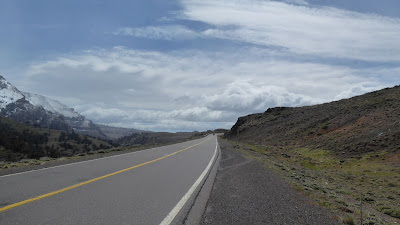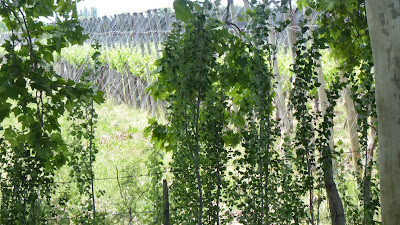On a long multi-day adventure ride there are days that offer pain and pleasure. Tuesday was one of those days, though there was more pain
than pleasure. You just have to keep faith that things will work
themselves out.
It was bucketing down on Tuesday morning, cold too, at just over 35F at 7.45
when I bailed out of the hostel. With a return home beckoning I just suited up and
left. It is 25 miles to Liucura the location of the Chlie/Argentina Complejo Frontier, leaving about 15 miles to reach the pass (Paso Hachado) and Argentina itself. Five
miles out from border control it started to snow, big wet flakes that stick
to the visor obscuring everything in front. What is it with me and snow when
crossing the Andes from Chile to Argentina? Paso de Jama redux.
Well, the border was closed due to weather when I arrived at 8.40, not a total surprise. There
is nowhere to wait at this border if the small café is closed, which it was. A wood stove was burning invitingly inside the border station, but they keep
the office door closed when the crossing is 'cerrado'. There are a couple of
overhangs where I sheltered with a group of hairy bummed truck drivers.....and
watched the snow accumulate on the moto.

It lightened up a couple of times, but then resumed the big
wet flakes. At one point the gutter on the roof stopped flowing, the
temperatures had obviously fallen, the snow had stopped melting. My spirits
sank with the temperature.
With a relatively short haul over the pass and the weather on the other side
forecast to be good I decided to wait it out, 9.40 became 10.40, the snow had
not abated but was not settling on the road. At 11am they opened the doors and
the border. Remember those hairy bummed truck drivers? Nicest guys you could
possibly meet, I presume taking pity on the ‘extranjero’ daft enough to be on
two wheels, they let me go first.
Javier at DakarMoto's had urged me to check the import paperwork to ensure it
was correct to avoid issues at the EZE export office. I spotted an error, the
guy had my nationality wrong and he corrected it to the UK, not the US (traveling
on my UK passport). Onward and upward..the roads had been plowed of the freshly
dropped 4-6 inches from the spring storm. The temperatures were below freezing,
the road remained wet but I slowed just in case. As I neared the highpoint windblown snow had returned to the road. With only a mile or so to crest
the paso I gingerly pressed on. Within a couple of miles after cresting this
was the view (west at left, east at right), temperatures in the 50's. Weather
changes in the mountains continue to astonish.

The road ahead...the pleasure returned.
That is until I turned north on Ruta 40 at Las Lajas. The
pain resumed, the wind was coming from the WNW, and was nasty, just downright
nasty except for a few stretches where 40 trends east. This is the valley of the
volcanoes, from the Argentinian side, copped another partial view of a cone. I could barely keep the bike upright from the
wind, even cocked on the side stand.
I was aware that Ruta 40 to Malargue retained an unpaved section, more ripio. The NatGeo map I checked suggested it would last about 30 miles, not too bad. When I entered the ripio the surface was reasonable with a light coating of gravel in places. I stopped to capture another smaller volcano.

About the point where I expected the ripio to end small
islands of blacktop appeared, lily pads in a pond of light gravel. With 100
miles left to get to Malargue I figured I would get there by about 6- 6.30pm.
But the lily pads disappeared, over the next 30-40 miles the odd old strip of
tarmac would appear along with 'Obras en Constuccion' signs. Not much evidence
of 'obras' or work, but a lot of 'construccion', evidenced by the 6-8 inches of
large 1-3 inch stone they had recently laid, mile upon wretched mile. Their
plan being to allow the passing traffic to helpfully grind and pack the stone
for future blacktop.
Trucks had passed and left a track, but with a 2-3 inch mini berm where the gap
is on the paired wheels on the tractor & trailer. It was an utterly
miserable 30 miles at 25-30mph. On a couple of occasions I inevitably put my
front wheel in some of the deeper stuff when the tracks merged or disappeared,
and once I nearly planted the bike on the ground; quick but smooth action on
the throttle to goose the speed straightened my fishtailing up. Thank you
motorcycle gods.
The reward, when it came, was in the form of utterly smooth fresh black
top.....70 mph, a couple of miles ...then slam on the brakes, no warning
signage to alert of a 100-200 yard interval of 2-3 inch stone, then back onto
the smooth stuff, this happened 2 or three times (I don't understand the logic
behind this approach to construction) before black top returned for good. I
reached Malargue at 7.30 with about 30 minutes of daylight to spare. 380 miles
and I was completely shot, but at least I was in Argentina and had the
paperwork to allow DakarMotos to start the booking process. I sent Javier a
picture of the TVIP, smugly noting that as requested I had carefully checked
the paperwork, found a mistake and had it corrected. Then I showered and left
for dinner, three blocks away at a nice place. Pleasure returned.
I was looking forward to a good sleep at Hostal Kathmandu, but before putting my head on the pillow
I checked emails. The pain returned, intensified... there was a number missing
from the VIN on the TVIP Javier advised. I would need to return to the closest
border (the nearest was over 100 miles one way) to get it fixed.
Noooooooooooo……...the pain was searing, how could I have been so dumb. Maybe
two + hours of watching snow fall in the cold and a desire to get moving on
what was a long day, delayed at the border, addled my brain at the aduana
window. Regardless, it was a silly lack of attention on my part, I needed a
plan of attack, but a fitful sleep came first.
At 4am my eyes pinged opened and I could not will them shut. Argentina has a fiscal office, the AFIP, that collects taxes, manages social security and so forth, one of the branches in AFIP is customs (Aduana). I had seen AFIP offices in various towns during my journey. Obviously tax collection and welfare are nationwide issues, customs control is an issue at points of entry and Javier at DakarMotos had warned that most AFIP offices do not have an aduana section.
San Rafael has an AFIP office, 115 miles distant but on the route to Buenos Aires. Google Maps showed a 'Zona Operativa Aduanera' in San Rafael, I guessed it was a free trade zone to serve the wine industry, speculating that as a consequence San Rafael AFIP would have an aduana section. The AFIP website was not helpful in confirming that. I resolved to try San Rafael. If unsuccessful the worst case was to head further north to Mendoza and onto the main border with Chile; Las Libertadores.
The office was easily located. With no parking on the street I followed the locals and rode up onto the sidewalk and parked. Sure enough there was a customs section in the AFIP office. The staff could not have been more helpful. In my best Spanish I explained the situation, showed them the documentation and the error. Ten minutes later I had the corrected document in hand and left. Found wifi and sent a picture of the document to DakarMoto's to grease the wheels.
My enthusiasm to visit Mendoza had evaporated, I continued on an easterly track eating 380 of the 750 miles to Buenos Aires. It is time to head home.
On the way I passed numerous vineyards; I could have been in France.
Realico, in far north La Pampa (and yes still in the Patagonia Region) reminded me of some towns in central Illinois. Flat land, streets laid out in a grid, clean with a conservative feel and reasonable wealth fueled by agriculture.
On arrival I contacted DakarMoto's for an update and when I told Javier where I was he commented 'there is nothing there except for a shitty gas station'. He was wrong about the gas station, it is modern and offered a full range of services to the traveler. He was right about the town though, excitement is not an emotion that has touched Realico, which is precisely why I decided to stay here a couple of nights and unwind from the last 6 days and 1,250 miles. I had my fill of excitement during that period.
When I checked into Hotel Juan Jose I bumped into Vincent from Buenos Aires, a septuagenarian leading a group of 7 bikes on a tour of 10 days or so. Vincent spoke a little English and with my modest Spanish we were able to dialogue. I met several of the group including his son Mauricio.
The town itself is spotlessly clean. As I mentioned it is conservative in feel and they take 'siesta' very seriously. At Noon they down tools and the streets are empty.
A town with money can afford to indulge in sculptures of a prehistoric animal and the current version, an armadillo and keep the flag flying in a spotless main square.
Realico's wealth is on display in the homes. I have not seen this quality of property in a town center in any other place in Argentina. The old brick building, if renovated, would make a ritzy panaderia and coffee store. But I don't think ritzy would be to the local's taste.
Back on the road Friday, 260 miles to Chivilcoy, (a town I passed by in late September) leaving the final 120 miles to the environs of the airport for Saturday, just south of Buenos Aires. By the time I arrive I should have the travel plans for the following week nailed down.
Cheers. T2




































